Benilexa 20 Micrograms/24 Hours Intrauterine Delivery System
SUMMARY OF PRODUCT CHARACTERISTICS
1 NAME OF THE MEDICINAL PRODUCT
Benilexa 20 micrograms/24 hours Intrauterine Delivery System
2 QUALITATIVE AND QUANTITATIVE COMPOSITION
The active substance is Levonorgestrel.
The intrauterine delivery system contains 52 mg levonorgestrel. The initial release of levonorgestrel is approximately 20 micrograms per day reducing to approximately 12 micrograms per day after 3 years.
For the full list of excipients, see section 6.1
3 PHARMACEUTICAL FORM
Intrauterine delivery system (IUS).
The product consists of an inserter and levonorgestrel IUS, which is loaded at the tip of the inserter. Inserter components are an insertion tube, plunger, flange, body and slider. The device consists of a white or almost white hormone-elastomer core, mounted on a T-body and covered in opaque tubing, which regulates the release of levonorgestrel. The T-body has a loop at the end of the vertical stem and two horizontal arms at the other end. Removal threads are attached to the loop.
4 CLINICAL PARTICULARS
4.1 Therapeutic indications
Contraception for up to three years.
Treatment of heavy menstrual bleeding for up to three years. Benilexa may be particularly useful in women with heavy menstrual bleeding requiring (reversible) contraception.
4.2 Posology and method of administration
In women of fertile age, Benilxa is inserted into the uterine cavity within seven days of the onset of menstruation. It can be replaced by a new system at any time of the cycle.
Post-partum insertion: To reduce the risk of perforation, postpartum insertions should be postponed until the uterus is fully involuted. Do not insert earlier than six weeks after delivery. If the patient is experiencing significant post-partum bleeding and/or pain then infection or other causes should be excluded before insertion. Benilexa can also be inserted immediately after the first trimester abortion.
Benilexa is effective for three years in the indications for contraception and heavy menstrual bleeding. Therefore it should be removed after 3 years of use.
If the user wishes to continue using the same method, a new system can be inserted at the same time, in which case no additional protection is required.
Paediatric population
Benilexa has not been studied in patients below 16 years of age. Benilexa is not indicated for use before menarche.
Patients with hepatic impairment
Benilexa is contraindicated in patients with liver tumour or other acute or severe liver disease (see section 4.3).
Instructions for use and handling
Benilexa is supplied in a sterile pack which should not be opened until required for insertion. The exposed product should be handled with aseptic precautions. If the seal of the sterile package is broken, the product should be discarded (see Section 6.6 for disposal instructions).
How to insert Benilexa
It is strongly recommended that Benilexa should only be inserted by physicians/health care professionals who are experienced in levonorgestrel IUS insertions and/or have undergone sufficient training for levonorgestrel IUS insertion.
In case of difficult insertion and/or exceptional pain or bleeding during or after insertion, please refer to section 4.4.
• Benilexa is supplied sterile having been sterilised with ethylene oxide. Do not resterilise. For single use only. Do not use if the inner package is damaged or open. Insert before the month shown on the label.
• Benilexa is inserted with the provided inserter (figure 1) into the uterine cavity by carefully following the insertion instructions.
The following insertion instruction will be provided in the box containing the IUS.
Please read the following instructions for use carefully as there may be some difference in the type of inserter device compared with other IUDs you have used previously.
Thickened mark
First indent
Plunger
Description
Levonorgestrel
containing cylinder
Lateral arms
Threads
Knobs
Insertion
tube
Second indent
Conditions for use
1. In women of fertile age, Benilexa is inserted within seven days of the onset of menstruation. It can be replaced by a new system at any time of the cycle.
2. It is strongly recommended that Benilexa should only be inserted by physicians/health care professionals who have undergone sufficient training and have read carefully these instructions before Benilexa insertion.
3. Benilexa is supplied in a sterile pack which should not be opened until required for insertion. The exposed product should be handled with aseptic precautions. Do not use if the inner package is damaged or open.
4. Determine the position (anteversion, retroversion) and size of the uterus by a gynaecological examination. Exclude pregnancy and contraindications.
5. Place a speculum, use appropriate antiseptic solution to clean the vagina and cervix.
6. Use cervical dilators if cervical stenosis is diagnosed. Do not force to overcome resistance.
7. Grasp the cervix with a Tenaculum forceps and apply a gentle traction in order to straighten alignment of the cervical canal and uterine cavity.
8. Determine the uterine depth by hysterometry. If uterine depth is < 5.5 cm discontinue the procedure.
Preparation for insertion


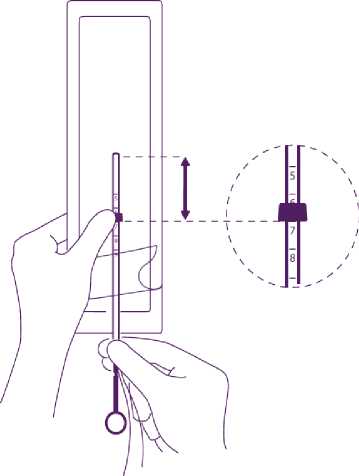
Introduce the plunger and the IUD in the insertion tube
Partly open the blister (about 1/3 from the bottom) and introduce the plunger in the insertion tube. Extricate the threads from the flange. Pull the thread to introduce the IUD into the tube. The arms of the IUD must stay in a horizontal plan, parallel to the flat side of the flange.
Position the lower edge of the flange at the sounded value
Position the blue flange so as the lower edge of the flange indicates the value found by hysterometry. The flat sides of the flange must always remain parallel to the arms. This will allow the arms to open correctly in the uterine cavity.
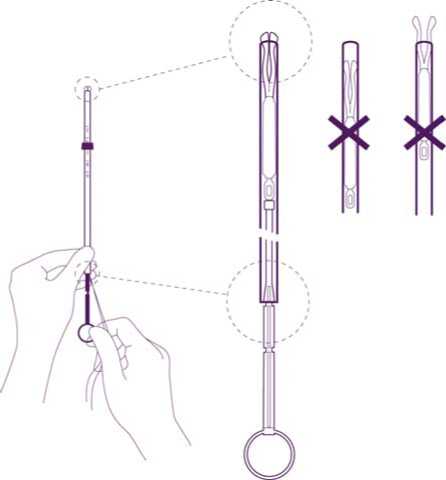
Insertion
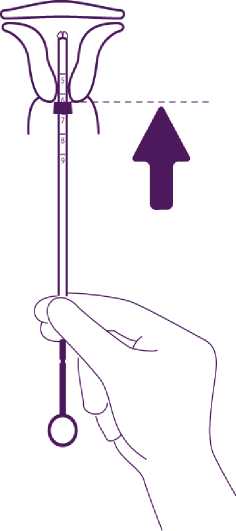
Adjust the position of the IUD in the insertion tube
Hold the plunger firmly while pulling the thread and moving the tube to adjust the IUDs position.
The knobs of the lateral arms must be closely opposed to each other, slightly above the upper extremity of the insertion tube (see zoom 1) and the distal edge of the tube must be aligned with the first indent of the plunger (see zoom 2). If the tube is not aligned with the first indent of the plunger you must pull the thread more firmly.
Introduce the device in the cervical canal until the blue flange is in contact with the cervix
Take the whole device out of the blister, by holding firmly the plunger and tube together in the correctly adjusted position.
Introduce the assembly into the cervical canal until the blue flange is in contact with the cervix.
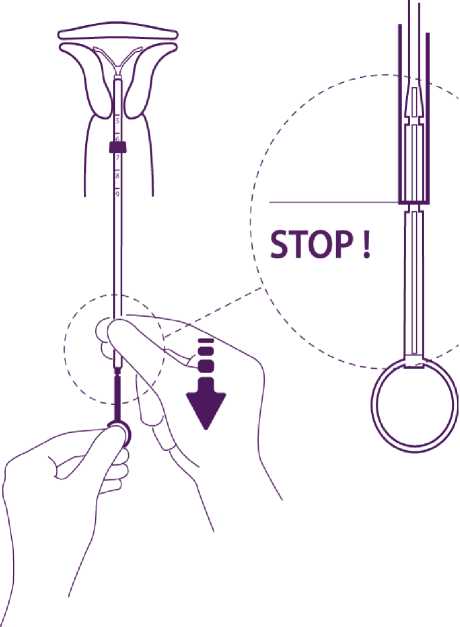
Release the arms of the
intrauterine device
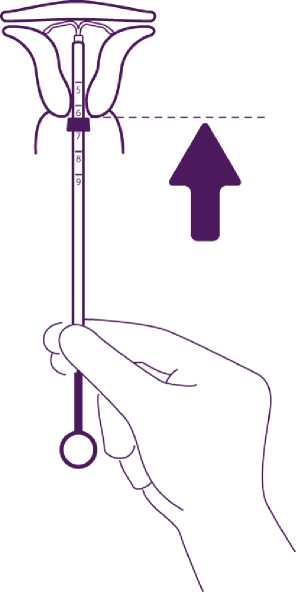
Hold the plunger, release the thread and pull the insertion tube down until its lower extremity reaches the second indent of the plunger.
Push the IUD against the fundus
To position the IUD in the uterine cavity, push the insertion tube simultaneously with the plunger, until the blue flange is again in contact with the cervix.
Benilexa is then correctly placed in the uterine cavity.
Release the IUD from the tube into the uterine cavity
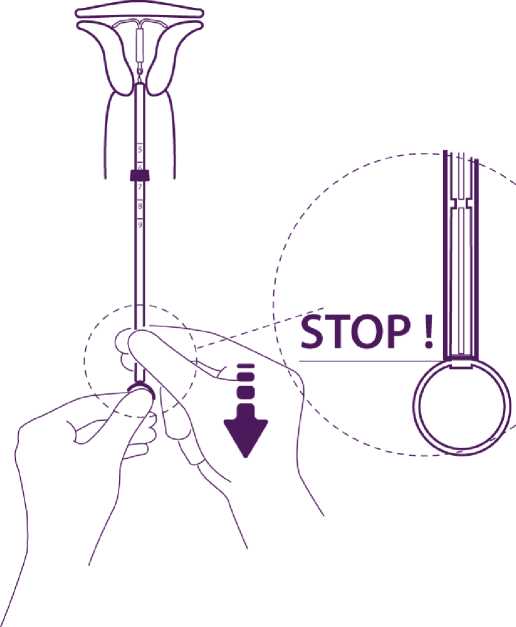
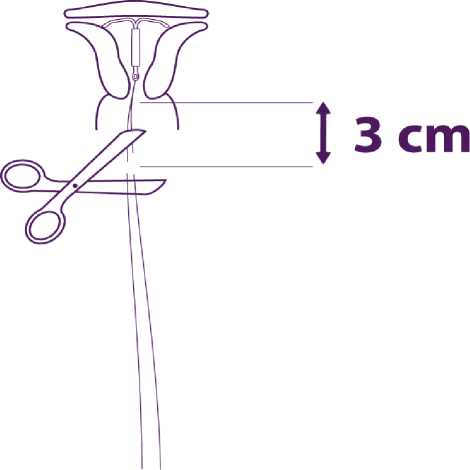
Without moving the plunger, pull the insertion tube down to the ring of the plunger.
A slight resistance marks the passage of the bulge of the plunger. Nevertheless pull down the tube to the ring of the plunger.
Benilexa is then released completely from the insertion tube.
Remove sequentially the inserter components and cut the threads
Remove sequentially, first the plunger, then the insertion tube.
Cut the threads at around 3 cm from the cervix.
IMPORTANT!
In case of difficult insertion and/or exceptional pain or bleeding during or after insertion, physical examination and ultrasound should be performed immediately to exclude perforation of the uterine body or cervix. If necessary remove the system and insert a new, sterile system.
Please report to our pharmacovigilance department any case of uterine perforation or insertion difficulties: Actavis UK Ltd. E-mail: medinfo@actavis.co.uk Phone: 01271 385257.
Benilexa is removed by gently pulling on the threads with forceps. If the threads are not visible and the device is in the uterine cavity, it may be removed using a narrow tenaculum. This may require dilatation of the cervical canal.
If pregnancy is not desired, the removal should be carried out during the menstruation in women of fertile age, provided that there appears to be a menstrual cycle. If the system is removed in the mid-cycle and the woman has had intercourse within a week, she is at a risk of pregnancy unless a new system is inserted immediately following removal.
After removal of Benilexa, the device should be checked to ensure it is intact. During difficult removals, single cases have been reported of the hormone cylinder sliding over the horizontal arms and hiding them together inside the cylinder. This situation does not require further intervention once completeness of the IUS has been ascertained. The knobs of the horizontal arms usually prevent complete detachment of the cylinder from the T-body.
4.3 Contraindications
• Known or suspected pregnancy
• Current or recurrent pelvic inflammatory disease
• Lower genital tract infection
• Postpartum endometritis
• Infected abortion during the past three months
• Cervicitis, Cervical dysplasia
• Suspected or confirmed uterine or cervical malignancy
• Liver tumour or other acute or severe liver disease
• Congenital or acquired abnormality of the uterus including fibroids if they distort the uterine cavity
• Undiagnosed abnormal uterine bleeding
• Conditions associated with increased susceptibility to infections
• Current or suspected hormone dependent tumours such as breast cancer (see section 4.4)
• Acute malignancies affecting the blood or leukaemias except when in remission
• Recent trophoblastic disease while hCG levels remain elevated
• Hypersensitivity to the active substance or to any of the excipients listed in section 6.1.
4.4 Special warnings and precautions for use Medical examination
Before insertion, a complete personal and family medical history should be taken. Physical examination should be guided by this and by the contraindications and warnings for use. Pulse and blood pressure should be measured and a bimanual pelvic examination performed to establish the orientation of the uterus. The patient should be re-examined six weeks after insertion and further examinations should be performed where clinically indicated and adapted to the individual woman rather than as routine procedure. Prior to insertion pregnancy should be excluded and genital infection should be successfully treated. Women should be advised that Benilexa does not protect against HIV (AIDs) and other sexually transmitted disease (please refer to the section below on pelvic infections).
Women should be encouraged to attend cervical and breast screening as appropriate for their age.
Conditions under which Benilexa can be used with caution
Benilexa may be used with caution after specialist consultation, or removal of the system should be considered, if any of the following conditions exist or arise for the first time during treatment:
- Migraine, focal migraine with asymmetrical visual loss or other symptoms indicating transient cerebral ischemia
- Unusually severe or unusually frequent headache
- Jaundice
- Marked increase of blood pressure
- Malignancies affecting the blood or leukaemias in remission
- Use of chronic corticosteroid therapy
- Past history of symptomatic functional ovarian cysts
- Active or previous severe arterial disease, such as stroke or myocardial infarction
- Acute venous thromboembolism
Benilexa may be used with caution in women who have congenital heart disease or valvular heart disease at risk of infective endocarditis.
Irregular bleedings may mask some symptoms and signs of endometrial polyps or cancer, and in these cases diagnostic measures have to be considered.
Benilexa is not the method of first choice for young nulligravid women.
In general, women using Benilexa should be encouraged to stop smoking.
Insertion / removal warnings and precautions
General Information: Insertion and removal may be associated with some pain and bleeding. In case of difficult insertion and/or exceptional pain or bleeding during or after insertion, physical examination and ultrasound should be performed immediately to exclude perforation of the uterine corpus or cervix (see also ‘Perforation’).
The procedure may precipitate fainting as a vasovagal reaction or a seizure in an epileptic patient. In the event of early signs of a vasovagal attack, insertion may need to be abandoned or the system removed. The woman should be kept supine, the head lowered and the legs elevated to the vertical position if necessary in order to restore cerebral blood flow. A clear airway must be maintained; an airway should always be at hand. Persistent bradycardia may be controlled with intravenous atropine. If oxygen is available it may be administered.
Perforation: Perforation or a penetration of the uterine corpus or cervix by an intrauterine contraceptive may occur rarely, most commonly during insertion. This may be associated with severe pain and continued bleeding. If perforation is suspected the system should be removed as soon as possible. The risk of perforation may be increased in post-partum insertions (see section 4.2), in lactating women and in women with a fixed retroverted uterus.
Pelvic infection: In users of copper intrauterine devices (IUDs), the highest rate of pelvic infections occurs during the first month after insertion and decreases later.
Known risk factors for pelvic inflammatory disease are multiple sexual partners, frequent intercourse and young age. Pelvic infection may have serious consequences as it may impair fertility and increase the risk of ectopic pregnancy. As with other gynaecological or surgical procedures, severe infection or sepsis (including group A streptococcal sepsis) can occur following IUS insertion, although this is extremely rare.
For women using Benilexa with symptoms and signs suggestive of pelvic infection, bacteriological examinations are indicated and monitoring is recommended even with discrete symptoms, and appropriate antibiotics should be started. There is no need to remove Benilexa unless the symptoms fail to resolve within the following 72 hours or unless the women wishes Benilexa to be removed. Benilexa must be removed if the women experiences recurrent endometritis or pelvic infection, or if an acute infection is severe.
Complications leading to failure
Expulsion: Symptoms of the partial or complete expulsion of any IUS may include bleeding or pain. However, a system can be expelled from the uterine cavity without the woman noticing it leading to loss of contraceptive protection. Partial expulsion may decrease the effectiveness of /Benilexa. As the device decreases menstrual flow, increase of menstrual flow may be indicative of an expulsion. A displaced Benilexa should be removed and a new system inserted. The woman should be advised how to check the threads of Benilexa and that she should immediately see her doctor if she cannot feel the threads.
Lost threads: If the retrieval threads are not visible at the cervix on follow-up examination, first exclude pregnancy. The threads may have been drawn up into the uterus or cervical canal and may reappear during the next menstrual period. If they cannot be found, they may have broken off, the system may have been expelled, or rarely the device may be extra-uterine after having perforated the uterus. An ultrasound should be arranged to locate the device and alternative contraception should be advised in the meantime. If an ultrasound cannot locate the device and there is no evidence of expulsion, a plain abdominal X-ray should be performed to exclude an extra-uterine device.
Bleeding irregularities
Irregular bleeding: Benilexa usually achieves a significant reduction in menstrual blood loss within 3 to 6 months of treatment. Increased menstrual flow or unexpected bleeding may be indicative of expulsion. If menorrhagia persists then the woman should be re-examined. An assessment of the uterine cavity should be performed using ultrasound scan. An endometrial biopsy should also be considered.
Risk in _pre-menopausal women
Because irregular bleeding/spotting may occur during the first months of therapy in pre-menopausal women, it is recommended to exclude endometrial pathology before insertion of Benilexa.
When to check for pregnancy in women of child bearing potential:. The possibility of pregnancy should be considered if menstruation does not occur within six weeks of the onset of previous menstruation and expulsion should be excluded. A repeated pregnancy test is not necessary in amenorrhoeic subjects unless indicated by other symptoms. In women of fertile age, oligomenorrhea and/or amenorrhea develops gradually in about 20% of the users.
Treatment review advice for Menorrhagia: Benilexa usually achieves a significant reduction in menstrual blood loss within 3 to 6 months of treatment. If significant reduction in blood loss is not achieved in these time-frames, alternative treatments should be considered.
Other risks during use
Ectopic pregnancy: Women with a previous history of ectopic pregnancy, tubal surgery or pelvic infection carry higher risk of ectopic pregnancy. The absolute risk of ectopic pregnancy in users of levonorgestrel IUS is low. However, when a woman becomes pregnant with Benilexa in situ, the relative likelihood of ectopic pregnancy is increased. The possibility of ectopic pregnancy should be considered in the case of lower abdominal pain - especially in connection with missed periods or if an amenorrhoeic woman starts bleeding. The rate of ectopic pregnancy in users of levonorgestrel IUS is 0.06 per 100 woman-years. This rate is lower than the rate of 0.3-0.5 per 100 woman-years estimated for women not using any contraception. The corresponding figure for the copper IUS is 0.12 per 100 woman years. Women with a previous history of ectopic pregnancy carry a higher risk of a further ectopic pregnancy.
Ovarian Cysts: Ovulatory cycles with follicular rupture usually occur in women of fertile age. Sometimes atresia of the follicle is delayed and folliculogenesis may continue. These enlarged follicles cannot be distinguished clinically from ovarian cysts. Data from clinical trials suggest that ovarian cysts have been reported as an adverse drug reaction in approximately 7% of women using Benilexa, however some published studies have reported a higher incidence of ovarian cysts (which could have been influenced by factors including frequency and criteria of ultrasound scanning, and patient population). Most of these follicles are asymptomatic, although some may be accompanied by pelvic pain or dyspareunia.
In most cases, the ovarian cysts disappear spontaneously during two to three months observation. Should this not happen, continued ultrasound monitoring and other diagnostic/therapeutic measures are recommended. Rarely, surgical intervention may be required.
Breast cancer:
Risk in pre-menopausal women
A meta-analysis from 54 epidemiological studies reported that there is a slightly increased relative risk (RR = 1.24) of having breast cancer diagnosed in women who are currently using combined oral contraceptives (COCs), mainly using oestrogen-progestogen preparations. The excess risk gradually disappears during the course of the 10 years after cessation of COC use. Because breast cancer is rare in women under 40 years of age, the excess number of breast cancer diagnoses in current and recent COC users is small in relation to the overall risk of breast cancer.
The risk of having breast cancer diagnosed in users of progestogen-only methods (POPs, implants and injectables), including Benilexa, is possibly of similar magnitude to that associated with COC. However, for progestogen-only contraceptive preparations, the evidence is based on much smaller populations of users and so is less conclusive than that for COCs.
Glucose tolerance: Low-dose levonorgestrel may affect glucose tolerance and blood glucose concentrations should be monitored in diabetic users of Benilexa.
Post-coital contraception: Benilexa is not for use as a post-coital contraceptive.
4.5 Interaction with other medicinal products and other forms of interaction
The metabolism of progestagens may be increased by concomitant use of substances known to induce drug-metabolizing enzymes, specifically cytochrome P450 enzymes, such as anticonvulsants (e.g., phenobarbital, phenytoin, carbamazepine) and anti-infectives (e.g. griseofulvin, rifampicin, rifabutin, nevirapine, efavirenz). On the other hand, substances known to inhibit drug-metabolizing enzymes (e.g. itraconazole, ketoconazole) may increase serum concentrations of levonorgestrel. The influence of these drugs on the contraceptive efficacy of Benilexa is not known, but it is not believed to be of major importance due to the local mechanism of action.
4.6 Fertility, pregnancy and lactation
Pregnancy: Benilexa is not to be used during an existing or suspected pregnancy. In case of an accidental pregnancy with Benilexa in situ (see section 5: pharmacological properties), ectopic pregnancy should be excluded (see section 4.4) and the system must be removed and termination of the pregnancy should be considered as there is a high risk for pregnancy complications (abortion, infection and sepsis). Removal of Benilexa or probing of the uterus may result in spontaneous abortion. Should these procedures not be possible or if the woman wishes to continue the pregnancy, the woman should be informed about these risks, and accordingly, such pregnancies should be closely monitored. The woman should be instructed to report all symptoms that suggest complications of the pregnancy, like cramping abdominal pain with fever.
Local exposure to levonorgestrel:
Because of the intrauterine administration and the local exposure to hormone, the possible occurrence of virilising effects in the foetus should be taken into consideration. Clinical experience of the outcomes of pregnancies with levonorgestrel IUS in situ is limited due to the high contraceptive efficacy, but the woman should be informed that, to date, there is no evidence of birth defects caused by local levonorgestrel IUS use in cases where pregnancy continues to term with the IUS in place.
Breastfeeding: Levonorgestrel is excreted in very small quantities in breast milk after use in levonorgestrel IUS. Since no risk for the child is expected, breast feeding can
be continued during use of benilexa. Uterine bleeding has rarely been reported in women using a levonorgestrel IUS during lactation.
Fertility: the use of levonorgestrel IUS does not alter the course of female fertility after removal of the IUS.
4.7 Effects on ability to drive and use machines
Benilexa has no known influence on the ability to drive or use machines.
4.8 Undesirable effects
Undesirable effects are more common during the first months after the insertion, and subside during prolonged use.
Very common undesirable effects (occurring in more than 10% of users) include uterine/vaginal bleeding including spotting, oligomenorrhoea, amenorrhoea (see section 5.1) and benign ovarian cysts.
The frequency of benign ovarian cysts depends on the diagnostic method used, and in clinical trials enlarged follicles have been diagnosed in 12% of the subjects using a levonorgestrel IUS. Most of the follicles are asymptomatic and disappear within three months.
The table below reports adverse reactions by MedDRA system organ class (MedDRA SOCs). The frequencies are based on clinical trial data.
|
Organ system |
Undesirable effects | |||
|
Very common: >1/10 |
Common: >1/100 to <1/10 |
Uncommon: >1/1000 to <1/100 |
Rare: >1/10000 to <1/1000 | |
|
Immune system disorders |
Hypersensitive including rash, urticaria and angioedema | |||
|
Psychiatric disorders |
Depressive mood Nervousness Decreased libido | |||
|
Nervous system disorders |
Headache |
Migraine | ||
|
Gastrointestinal |
Abdominal |
Abdominal | ||
|
disorders |
pain Nausea |
distension | ||
|
Skin and subcutaneous tissue disorders |
Acne |
Alopecia Hirsutism Pruritus Eczema Chloasma/skin hyperpigmentation |
Rash Urticaria | |
|
Musculoskeletal and connective tissue disorders |
Back pain | |||
|
Reproductive system and breast disorders |
Uterine/vaginal bleeding including spotting, oligomenorrhea, amenorrhea Benign ovarian cysts |
Pelvic pain Dysmenorrhoea Vaginal discharge Vulvovaginitis Breast tenderness Breast pain |
Pelvic Inflammatory disease Endometritis Cervicitis Papanicolaou smear normal, class II |
Uterine perforation |
|
General disorders and administration site conditions |
Intrauterine contraceptive device expelled |
Oedema | ||
|
Investigations |
Weight increase |
Infections and infestations
Cases of sepsis (including group A streptococcal sepsis) have been reported following IUS insertion (see section 4.4)
Pregnancy, puerperium and perinatal conditions
When a woman becomes pregnant with Benilexa in situ, the relative risk of ectopic pregnancy is increased (see ‘Special warnings and precautions for use’ and ‘Fertility, pregnancy and lactation’).
Reproductive system and breast disorders
Cases of breast cancer have been reported in levonorgestrel IUS users (frequency unknown, see section 4.4).
The following adverse reactions have been reported in connection with the insertion or removal procedure of Benilexa: pain, bleeding, and insertion-related vasovagal reaction with dizziness or syncope (see section 4.4). The procedure may also precipitate a seizure in patients with epilepsy.
Reporting of suspected adverse reactions
Reporting suspected adverse reactions after authorisation of the medicinal product is important. It allows continued monitoring of the benefit/risk balance of the medicinal product. Healthcare professionals are asked to report any suspected adverse reactions via the Yellow Card Scheme Website: www.mhra.gov.uk/yellowcard
4.9 Overdose
Not applicable.
5 PHARMACOLOGICAL PROPERTIES
5.1 Pharmacodynamic properties
Pharmacotherapeutic group: Intrauterine contraceptives, plastic IUD with progestogen ATC code: G02BA03
Levonorgestrel is a progestogen used in gynaecology in various ways: as the progestogen component in oral contraceptives, in hormonal replacement therapy or alone for contraception in minipills and subdermal implants. Levonorgestrel can also be administered directly into the uterine cavity as an IUS. This allows a very low daily dosage, as the hormone is released directly into the target organ.
The contraceptive mechanism of action of the levonorgestrel IUS is based mainly on hormonal effects producing the following changes:
Prevention of proliferation of the endometrium
Thickening of the cervical mucus thus inhibiting the passage of sperm
Suppression of ovulation in some women.
The physical presence of the system in the uterus would also be expected to make a minor contribution to its contraceptive effect.
When inserted according to the insertion instructions, Benilexa has a contraceptive failure rate of approximately 0.19% (95% Cl: 0.05% - 0.75%) per year. The failure rate may increase in case of the Benilexa expulsion or perforation.
Levonorgestrel IUS may be particularly useful for contraception in patients with heavy menstrual bleeding, and can be successfully used in the treatment of idiopathic menorrhagia.
The volume of menstrual bleeding was decreased by 88% in menorrhagic women by the end of three months of use. Menorrhagia caused by submucosal fibroids may respond less favourably. Reduced bleeding promotes the increase of blood haemoglobin in patients with menorrhagia.
In idiopathic menorrhagia, prevention of proliferation of the endometrium is the probable mechanism of action of levonorgestrel IUS in reducing blood loss.
Bleeding Patterns:
Different kinds of bleeding changes (frequent, prolonged or heavy bleeding, spotting, oligomenorrhea, amenorrhoea) are experienced by all users of levonorgestrel IUS. In fertile women the average number of spotting days/month decreases gradually from nine to four days during the first six months of use. The percentage of women with prolonged bleeding (more than eight days) decreases from 20% to 3% during the first three months of use. In clinical studies during the first year of use, 17% of women experienced amenorrhoea of at least three months duration.
5.2 Pharmacokinetic properties
The initial release of levonorgestrel from Benilexa is 20 micrograms/24 hours, delivered directly into the uterine cavity. Because of the low plasma concentrations, there are only minor effects on the metabolism. Estimated in vivo release rates at different time points, based on observed ex vivo residual content data from selected expelled or removed systems in women using Benilexa for contraception, are shown below:
|
Time |
Estimated average in vivo release rate [micrograms/24 hours] |
|
After initial insertion |
18.6 |
|
1 year after insertion |
16.3 |
|
2 years after insertion |
14.3 |
|
3 years after insertion |
12.6 |
|
Average over 3 years |
15.6 |
The pharmacokinetics of levonorgestrel itself have been extensively investigated and reported in the literature. In a study of non-obese women using Benilexa for contraception, mean plasma levonorgestrel concentration of 310 ± 140 pg/ml was determined at seven days after insertion, with plasma concentrations of 192 ± 36 pg/ml, 178 ± 38 pg/ml and 139 ± 42 pg/ml after 56 weeks, 24 months and 36 months respectively.
A half life of 20 hours is considered the best estimate although some studies have reported values as short as 9 hours and others as long as 80 hours. Another important finding, although one in agreement with experience with other synthetic steroids, has been marked differences in metabolic clearance rates among individuals, even when administration was by the intravenous route. Levonorgestrel is extensively bound to proteins (mainly sex hormone binding globulin [SHBG]) and extensively metabolised to a large number of inactive metabolites.
5.3 Preclinical safety data
Non-clinical data reveal no special hazard for humans other than the information already included in other sections of the SmPC. These data are based on conventional studies of safety pharmacology, repeated dose toxicity, genotoxicity, carcinogenic potential and toxicity to reproduction and development.
6 PHARMACEUTICAL PARTICULARS
6.1 List of excipients
Polydimethylsiloxane elastomer Polydimethylsiloxane tubing Polyethylene T-frame with 20-24% barium sulphate Polypropylene thread Copper phthalocyanine blue
6.2 Incompatibilities
Not applicable
6.3 Shelf life
4 years
6.4 Special precautions for storage
Store in the original package. Keep the pouch in the outer carton in order to protect from light.
6.5 Nature and contents of container
Benilexa IUS with the inserter device is individually packed into a thermoformed blister (polyester) package with a peelable lid (TYVEK-Polyethylene).
6.6 Special precautions for disposal
As the insertion technique is different from intrauterine devices, special emphasis should be given to training in the correct insertion technique. Special instructions for insertion are in the package.
Benilexa is supplied in a sterile pack which should not be opened until required for insertion. Each system should be handled with aseptic precautions. If the seal of the sterile envelope is broken, the system inside should be disposed of in accordance with the local guidelines for the handling of biohazardous waste. Likewise, a removed Benilexa and inserter should be disposed of in this manner. The outer carton package and the inner blister package can be handled as household waste.
7 MARKETING AUTHORISATION HOLDER
Actavis Group PTC ehf.
Reykjavikurvegi 76-78 220 Hafnarfjordur Iceland
8 MARKETING AUTHORISATION NUMBER(S)
PL 30306/0509
9 DATE OF FIRST AUTHORISATION/RENEWAL OF THE AUTHORISATION
20/02/2015 20/02/2015